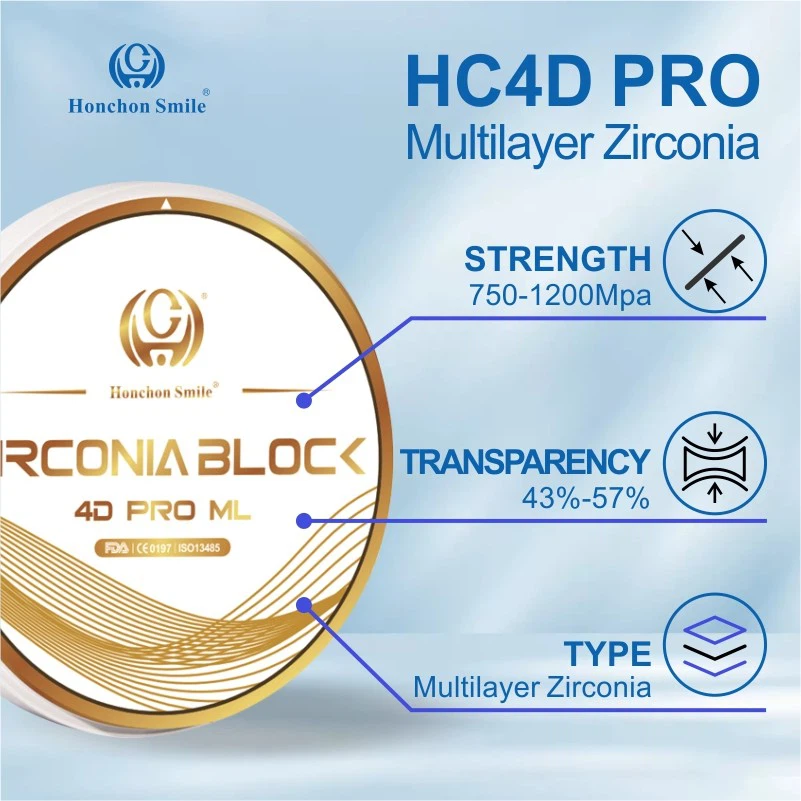Dental zirconia has become a cornerstone in modern restorative dentistry, offering high strength, biocompatibility, and aesthetic versatility. However, not all zirconia is created equal. Understanding the difference between single-layer zirconia and multi-layer zirconia is essential for selecting the most suitable material for both anterior and posterior restorations.
Definition:
Single-layer zirconia is a homogenous dental ceramic, meaning the entire block or disc has the same composition, microstructure, and yttria (Y2O3) content throughout. This uniformity ensures consistent mechanical properties such as flexural strength, fracture toughness, and wear resistance across the entire restoration.
Characteristics:
High and uniform strength, ideal for posterior crowns and bridges where load-bearing is critical.
Limited translucency compared to natural teeth, although newer ultra-translucent formulations have improved aesthetics.
Color and shade require external staining or glazing to match the surrounding dentition.
Applications:
Posterior crowns and bridges where strength is prioritized over aesthetics.
Implant-supported prosthetics requiring high fracture resistance.
Cases where uniform mechanical performance is critical.
Advantages:
Predictable mechanical performance: uniform composition means no weak layer exists.
Greater flexural strength and fracture resistance, especially useful for long-span bridges.
Cost-effective for large-scale restorations where aesthetics can be managed externally.
Definition:
Multi-layer zirconia is engineered with gradients of composition, translucency, and color within a single block or disc. It typically includes an enamel layer, a transition layer, and a dentin/bulk layer, each with different Y2O3 content and microstructure to better replicate the optical properties of natural teeth.
Characteristics:
Outer layers: lower Y2O3 content → higher translucency and enamel-like aesthetics.
Inner layers: higher Y2O3 content → higher strength for functional load-bearing.
Integrated color gradient reduces or eliminates the need for external staining.
Can mimic natural tooth characteristics such as incisal translucency, cervical shade, and overall tooth depth.
Applications:
Anterior restorations where aesthetics are critical.
Single crowns or short-span bridges requiring a natural appearance without compromising strength.
Cases where clinical workflow efficiency is valued, reducing staining and adjustment time.
Advantages:
Enhanced aesthetics: Natural color and translucency gradient closely replicate real teeth.
Balanced performance: Strength is optimized internally while outer layers provide natural appearance.
Simplified workflow: Reduces lab or clinical steps for coloring and shading.
Functional gradient: Mechanical properties are tailored to the position of the tooth (incisal vs cervical), improving long-term durability.
Potential Considerations:
Mechanical properties vary layer by layer; inner layers provide high toughness, but the enamel layer may have slightly lower fracture resistance.
Not all multi-layer zirconia systems are equal—high-quality materials achieve smooth gradient transitions in color, translucency, and strength.
| Feature | Single-Layer Zirconia | Multi-Layer Zirconia |
|---|---|---|
| Composition | Uniform | Gradient (enamel, transition, dentin) |
| Mechanical Strength | Consistent throughout | Varies by layer (inner layer stronger) |
| Aesthetic Quality | Requires staining/glazing | Built-in gradient mimics natural teeth |
| Translucency | Moderate to high (depending on type) | Optimized per layer for natural appearance |
| Workflow | May require additional shading | Reduced staining steps |
| Best Use | Posterior crowns, long-span bridges | Anterior crowns, aesthetic restorations, short bridges |
| Customization | Shade customization externally | Shade gradient built-in, less lab work |
Posterior Restorations: Single-layer zirconia is preferred for high-load areas because of its uniform strength.
Anterior Restorations: Multi-layer zirconia excels where aesthetics and natural translucency are critical.
Bridges: For short-span anterior bridges, multi-layer zirconia offers a natural look while maintaining sufficient strength. For long-span posterior bridges, single-layer zirconia is often safer.
Workflow Efficiency: Multi-layer zirconia reduces the need for additional staining or layering, saving chairside and lab time.
Some high-end systems, like HONCHON 4D Multilayer Zirconia, go beyond simple three-layer designs. They provide:
Continuous gradient in color, translucency, strength, and hardness.
Realistic enamel-like incisal translucency and dentin shade.
Optimized internal strength for both anterior and posterior applications.

These advanced blocks enable restorations that are both functionally robust and visually indistinguishable from natural teeth, meeting modern aesthetic and clinical demands.
To learn more about HONCHON 4D pro, click this link
Single-layer zirconia provides predictable mechanical strength and is ideal for load-bearing restorations, particularly in the posterior region. Multi-layer zirconia offers superior aesthetics and gradient mechanical properties, reducing clinical workflow steps and producing natural-looking anterior restorations.
Choosing between single-layer and multi-layer zirconia should consider:
Tooth position (anterior vs posterior)
Desired aesthetics
Load-bearing requirements
Workflow efficiency
Long-term durability
By understanding the science behind zirconia layers and their clinical performance, dentists and dental technicians can select the most appropriate material to balance strength, beauty, and efficiency.